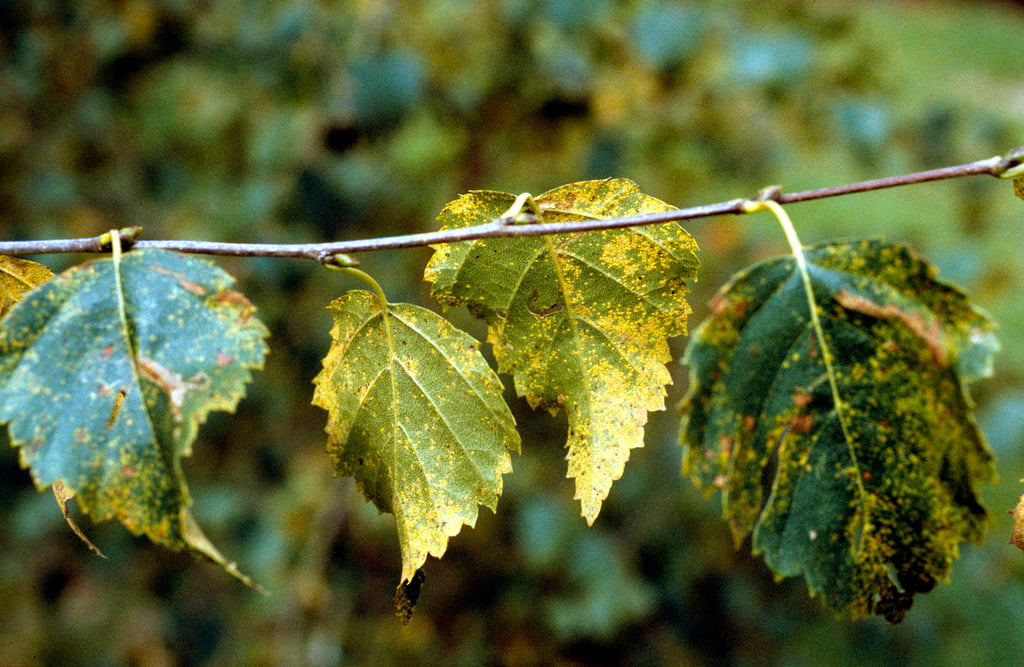Tree rusts
Tree rusts are fungal diseases causing dusty orange, brown or black spots (pustules) on the leaves of poplar, willow, birch and plum, and cankers on the stems and branches of five-needled pine.

Quick facts
Scientific name Various
Plants affected Mainly Populus spp. (poplar), Salix spp. (willow), Betula spp. (birch), plum and Pinus spp. (five-needled pine)
Main symptoms Orange or brown pustules
Caused by Fungi
Timing Various
What are tree rusts?
Tree rusts cause eye-catching infections on the leaves of some trees, particularly Populus spp. (poplar), Salix spp. (willow), Betula spp. (birch) and plum, and cankers on the stems and branches of Pinus spp. (five-needled pines). Tree rusts may be seen from spring until autumn for trees that lose their leaves in winter (deciduous) and all year on evergreens.
These are the rust fungi involved:
- Poplar rust is caused by several species of Melampsora
- Willow rust is also caused by several species of Melampsora, but not the same as those infecting poplars
- Birch rust is caused by Melampsoridium betulinum
- Plum rust is caused by Tranzschelia discolor
- Five-needled pines are infected by white pine blister rust, caused by Cronartium ribicola
Symptoms
You may see the following symptoms:
On poplar, willow, birch and plum
- Poplar, willow and birch: Dusty orange spots (pustules) on the undersides of the leaves
- Plum: Dark brown pustules on the undersides of the leaves
- For all: There are usually small yellow or brown spots on the upper leaf surface, corresponding to the pustules on the lower surface. In severe attacks there can be many pustules on each leaf. Sometimes the orange pustules are intermingled with black ones. Affected leaves fall prematurely
On five-needled pines
- Small yellow swellings appear in spring at the base of the needles. In following years these develop as white blisters which liberate dusty orange spores
- Cankers develop on the stems and if they girdle the stem, it dies
Control
The RHS believes that avoiding pests, diseases and weeds by good practice in cultivation methods, cultivar selection, garden hygiene and encouraging or introducing natural enemies, should be the first line of control. If chemical controls are used, they should be used only in a minimal and highly targeted manner.
Non-chemical control
- There is normally no need to control these rusts in gardens, because they do little damage
- Removal of alternate hosts (see 'biology' section below) may be useful, but only if these are not also found in neighbouring gardens, because the spores are airborne
- Destroying fallen leaves in autumn, by burning or composting, may reduce the amount of resting spores available to reinfect next year. This only works if neighbouring gardens do the same, or if the relevant tree is not also growing nearby
- Remove pine branches with rust cankers, particularly if dieback occurs
Fungicides
The RHS recommends that you don't use fungicides. Fungicides (including organic types) may reduce biodiversity, impact soil health and have wider adverse environmental effects. If you do intend to use a fungicide, please read the information given in the links and download below to ensure that use, storage and disposal of the product is done in a responsible and legally compliant manner. Rust diseases affecting the foliage have little or no effect on the vigour of mature trees.
The products listed in the ‘Fungicides for gardeners’ document below are legally available for use by home gardeners in the UK. This information is provided to avoid misuse of legal products and the use of unauthorised and untested products, which potentially has more serious consequences for the environment and wildlife than when products are used legally. Homemade products are not recommended as they are unregulated and usually untested.
Download
Fungicides for gardeners (Adobe Acrobat pdf document outlining fungicides available to gardeners)
Links
Chemicals: using a sprayer
Chemicals: using safely and effectively
Chemicals: storing and disposing safely
Biology
Rust fungi are biotrophs: they feed from the living cells of the host plant over an extended period without killing them. They are not able to feed from dead plant material, so rusts affecting deciduous trees must either alternate with a different host plant or produce resting spores in order to pass the dormant season.
Poplar rust, caused by several species of Melampsora, appears in autumn and although spectacular, causes little damage in gardens. The alternate hosts are Larix (larch), Mercurialis perennis (dog’s mercury) and Allium spp. (wild onions).
Willow rust is also caused by several species of Melampsora, not the same as those infecting poplars. The alternate hosts include Euonymus, Larix (larch), Ribes, Saxifraga and some orchids. There is one Melampsora species that carries out its whole life cycle on Salix (willow).
Birch rust (Melampsoridium betulinum) alternates its life cycle with Larix (larch), but since both are deciduous it is also thought to overwinter in buds, as well as producing resting spores.
Plum rust (Tranzschelia discolor) alternates with Anemone coronaria and A. x fulgens. Like poplar rust, it develops late in the season and does little damage. Fruit are not affected.
White pine blister rust (Cronartium ribicola) is a very serious disease of commercial five-needled pines in Europe and the USA. Pinus flexilis, P. lambertiana, P. monticola and P. strobus are susceptible. This rust is a damaging pathogen because it forms girdling cankers on the stems. The alternate hosts are currants, particularly blackcurrants, and gooseberries, which are not seriously damaged.
Some other trees are affected by rusts, but seldom to the same level as those discussed here.
Get involved
The Royal Horticultural Society is the UK’s leading gardening charity. We aim to enrich everyone’s life through plants, and make the UK a greener and more beautiful place.